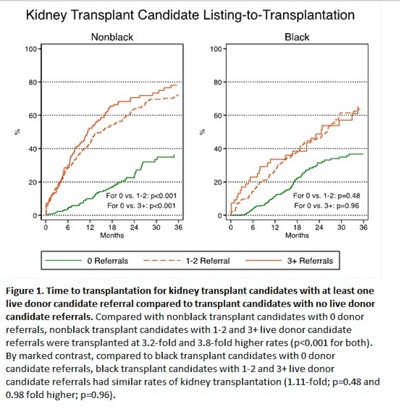Time to Kidney Transplantation Following Live Donor Candidate Referral.
Surgery, Johns Hopkins University, Baltimore, MD
Meeting: 2017 American Transplant Congress
Abstract number: 376
Keywords: African-American, Donation, Kidney
Session Information
Session Name: Concurrent Session: Logistic and Programatic Challenges in Kidney Living Donation
Session Type: Concurrent Session
Date: Monday, May 1, 2017
Session Time: 4:30pm-6:00pm
 Presentation Time: 5:06pm-5:18pm
Presentation Time: 5:06pm-5:18pm
Location: E450b
Kidney transplant candidates have utilized novel methods to identify and refer willing donors; however, delays or barriers to actually achieving live donor kidney transplantation are not well quantified. METHODS: We studied 1,528 kidney transplant candidates at our center and the live donor candidates referred on their behalf between 01/2011-03/2015. Using Cox regression, we compared the time from listing to transplantation for kidney transplant candidates who subsequently had 0, 1-2, and >3 donor candidates come forward to be evaluated on their behalf. RESULTS: Among nonblack transplant candidates, number of donor referrals was significantly associated with kidney transplantation ([aHR]: 2.323.224.46; 1-2 vs. 0 referrals; p<0.001; aHR: 2.663.815.46; >3 vs. 0 referrals; p<0.001).  However, among black transplant candidates, no association was found between donor referral and transplantation (aHR: 0.821.111.51; 1-2 vs. 0 referrals; p=0.5; aHR: 0.640.991.54; >3 vs. 0 referrals; p>0.9). Compared with nonblack donor candidates, referred black donor candidates were more likely to live within 50 miles of the transplant center (64% vs. 38%), to be biologically related to the transplant candidate (68% vs. 44%), and to be deemed medically ineligible (42% vs. 24%). HTN (45% vs. 24%) and BMI (33% vs. 25%) were the most common causes of medical ineligibility for black donor candidates. Furthermore, black donor candidates spent a longer time from medical screening to evaluation.
However, among black transplant candidates, no association was found between donor referral and transplantation (aHR: 0.821.111.51; 1-2 vs. 0 referrals; p=0.5; aHR: 0.640.991.54; >3 vs. 0 referrals; p>0.9). Compared with nonblack donor candidates, referred black donor candidates were more likely to live within 50 miles of the transplant center (64% vs. 38%), to be biologically related to the transplant candidate (68% vs. 44%), and to be deemed medically ineligible (42% vs. 24%). HTN (45% vs. 24%) and BMI (33% vs. 25%) were the most common causes of medical ineligibility for black donor candidates. Furthermore, black donor candidates spent a longer time from medical screening to evaluation.  CONCLUSIONS: The number of donor referrals does not increase transplant rates for black transplant candidates, in part due to donor medical combordity. Thus, donor recruitment initiatives among black transplant candidates should aim to broaden social networks to achieve transplantation.
CONCLUSIONS: The number of donor referrals does not increase transplant rates for black transplant candidates, in part due to donor medical combordity. Thus, donor recruitment initiatives among black transplant candidates should aim to broaden social networks to achieve transplantation.
CITATION INFORMATION: Kumar K, Tonascia J, Muzaale A, Poon A, Purnell T, Garonzik-Wang J, King E, Bowring M, Massie A, Segev D. Time to Kidney Transplantation Following Live Donor Candidate Referral. Am J Transplant. 2017;17 (suppl 3).
To cite this abstract in AMA style:
Kumar K, Tonascia J, Muzaale A, Poon A, Purnell T, Garonzik-Wang J, King E, Bowring M, Massie A, Segev D. Time to Kidney Transplantation Following Live Donor Candidate Referral. [abstract]. Am J Transplant. 2017; 17 (suppl 3). https://atcmeetingabstracts.com/abstract/time-to-kidney-transplantation-following-live-donor-candidate-referral/. Accessed December 31, 2025.« Back to 2017 American Transplant Congress
